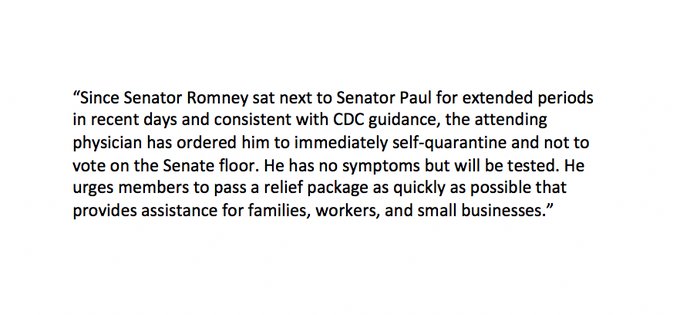
Getty Rand Paul has coronavirus.
U.S. Senator Rand Paul has tested positive for coronavirus, or COVID-19. The Senator confirmed the diagnosis through his official Twitter page on March 22, 2020, becoming the latest political figure and the first U.S. Senator to test positive for coronavirus.
“Senator Rand Paul has tested positive for COVID-19. He is feeling fine and is in quarantine. He is asymptomatic and was tested out of an abundance of caution due to his extensive travel and events. He was not aware of any direct contact with any infected person,” the tweet reads.
The Senator’s Twitter page also wrote, “He expects to be back in the Senate after his quarantine period ends and will continue to work for the people of Kentucky at this difficult time. Ten days ago, our D.C. office began operating remotely, hence virtually no staff has had contact with Senator Rand Paul.”
The announcement led other Senators, who had contact with Paul, to go into self-quarantine, such as Mitt Romney and Mike Lee, of Utah.
According to Axios, Paul was the only senator to cast a no vote against the $8 billion emergency coronavirus funding bill. His amendment to switch funding sources was voted down.
Here’s what you need to know:
Paul’s Many Contacts Inside Congress Are Raising Concern to Some
Some people were already raising concerns about other people Paul might have been in contact with. Manu Raju, senior congressional correspondent for CNN, tweeted the above photo and wrote, “I took a picture inside the Senate GOP lunch when the door was open Friday and saw Rand Paul seated next to other senators. He is visible in this photo.”
Then came word Paul was swimming in the pool.
Paul is being criticized by many on Twitter for not self-quarantining earlier and for getting a test despite having no symptoms when Americans with symptoms can’t always get them. “What? @RandPaul has no Covid symptoms and was tested “out of an abundance of caution” yet thousands of Americans are desperately ill and cannot get a test? This is so wrong on so many levels that I cannot wrap my brain around it,” wrote one woman on Twitter, echoing the feelings of others. “Rand Paul – a doctor – going to the Senate gym while awaiting results of a COVID test is about 1000 times more irresponsible than the very irresponsible spring breakers everyone is dunking on,” wrote Dan Pfeiffer, a former Barack Obama advisor.
Paul Recently Weighed In About Civil Liberty Concerns Regarding the Coronavirus Crisis
Just a few hours before the tweet showing he has COVID-19, Rand Paul tweeted out a Politico story that was headlined, “DOJ seeks new emergency powers amid coronavirus pandemic.”
He wrote: “We absolutely must, must, resist government run amok taking advantage of a crisis. This is how your liberty dies. Stand up America and resist.”
On March 20, 2020, an opinion column he wrote on coronavirus ran on The Hill. “I have already advocated for several commonsense proposals that would expand the availability of urgently needed items such as masks and respirators. I’ve introduced legislation to speed the testing and production of drugs and vaccines,” it says in part.
People around the country have reported being unable to get tested for coronavirus, despite suffering the symptoms or even having overseas travel.
Paul’s column advocated for measures such as a payroll tax holiday, expanding the unemployment system, deferred payments on bank loans, and pushing back the tax due date.
Other Politicians Have Also Tested Positive for Coronavirus But Top Government Officials like Mike Pence & Donald Trump Tested Negative
Among the other politicians who tested positive for COVID-19: Mario Diaz-Balart and Ben McAdams, U.S. Representatives from Florida and Utah. They both have also confirmed that they have coronavirus, according to NBC Miami.
On March 18, 2020, Diaz-Balart wrote on Twitter, “I’m feeling much better. However, it’s important that everyone take this seriously and follow @CDCgov guidelines in order to avoid getting sick & mitigate the spread of this virus. We must continue to work together to emerge stronger as a country during these trying times.”
After he was photographed with a Brazilian figure who tested positive for coronavirus, President Donald Trump underwent a test but said it was negative. Vice President Mike Pence and his wife, Karen, have also tested negative for the virus.
Coronavirus Is a Respiratory Illness

GettyTourist wearing a protective respiratory mask tours outside the Colosseo monument (Colisee, Coliseum) in downtown Rome on February 28, 2020 amid fear of Covid-19 epidemic.
According to Centers for Disease Control and Prevention, coronavirus and the flu share commonalities. “COVID-19 symptoms are similar to those of influenza (e.g., fever, cough, and shortness of breath), and the current outbreak is occurring during a time of year when respiratory illnesses from influenza and other viruses, including other coronaviruses that cause the ‘common cold,’ are highly prevalent,” the site reports.
CNN reports the following:
If you have itchy eyes or a runny nose, you probably have seasonal allergies or just a common cold. That’s because those common ailments are generally confined to the head and nasal areas.
In contrast, according to CNN, coronavirus and flu symptoms tend to affect the whole body. CNN says coronavirus and the flu are less likely to be associated with a runny nose because they “affect other systems and the lower respiratory tract,” although symptoms can include “a sore throat, a cough, a fever or shortness of breath.”
Shortness of breath and a fever are a good way to tell that it isn’t just seasonal allergies or a common cold. Furthermore, you’ll probably end up in bed with coronavirus or the flu, and it will be more obvious that you are sick.
The shortness of breath symptom is a really good indicator of coronavirus, but some people with the flu also get pneumonia, so that can be tricky to decipher. At the earliest stages, the symptoms for all three can seem similar and even mild, according to CNN.
Experts don’t just look at symptoms; they also look at the context around your symptoms, according to CNN. This can include whether you’ve traveled, been exposed to someone with coronavirus, been on a cruise ship, or associated with someone who’s done those things or been in an area with a coronavirus outbreak.
The Centers for Disease Control and Prevention indicates this additional information about coronavirus symptoms:
The following symptoms may appear 2-14 days after exposure.
Fever
Cough
Shortness of breath
Emergency warning signs include:
Difficulty breathing or shortness of breath
Persistent pain or pressure in the chest
New confusion or inability to arouse
Bluish lips or face
Harvard Medical School notes of coronavirus, “Some people infected with the virus have no symptoms. When the virus does cause symptoms, common ones include low-grade fever, body aches, coughing, nasal congestion, runny nose, and sore throat. However, COVID-19 can occasionally cause more severe symptoms like high fever, severe cough, and shortness of breath, which often indicates pneumonia.”
What is the incubation period? “Because this coronavirus has just been discovered, the time from exposure to symptom onset (known as the incubation period) for most people has yet to be determined. Based on current information, symptoms could appear as soon as three days after exposure to as long as 13 days later. Recently published research found that on average, the incubation period is about five days,” says Harvard.
What about flu symptoms? According to CDC: “The symptoms of flu can include fever or feeling feverish/chills, cough, sore throat, runny or stuffy nose, muscle or body aches, headaches and fatigue (tiredness). Cold symptoms are usually milder than the symptoms of flu. People with colds are more likely to have a runny or stuffy nose. Colds generally do not result in serious health problems.”
Of coronavirus, Guardian reports, “The virus can cause pneumonia. Those who have fallen ill are reported to suffer coughs, fever and breathing difficulties. In severe cases there can be organ failure. As this is viral pneumonia, antibiotics are of no use. The antiviral drugs we have against flu will not work. Recovery depends on the strength of the immune system. Many of those who have died were already in poor health.”
BBC notes that it’s impossible to get a true mortality rate for the flu because “people with mild flu symptoms choose never to visit a doctor.” It’s tough to know how many people have coronavirus but survive too because of the lack of widespread testing.
Some estimates give the case fatality rate with seasonal flu in the United States as less than 0.1%. Mortality rate for SARS was 10%, and for MERS 34%. The New York Times puts the death rate for flu at typically around 0.1% in the U.S., according to The New York Times.
READ NEXT: Can You Get Coronavirus From Money?



